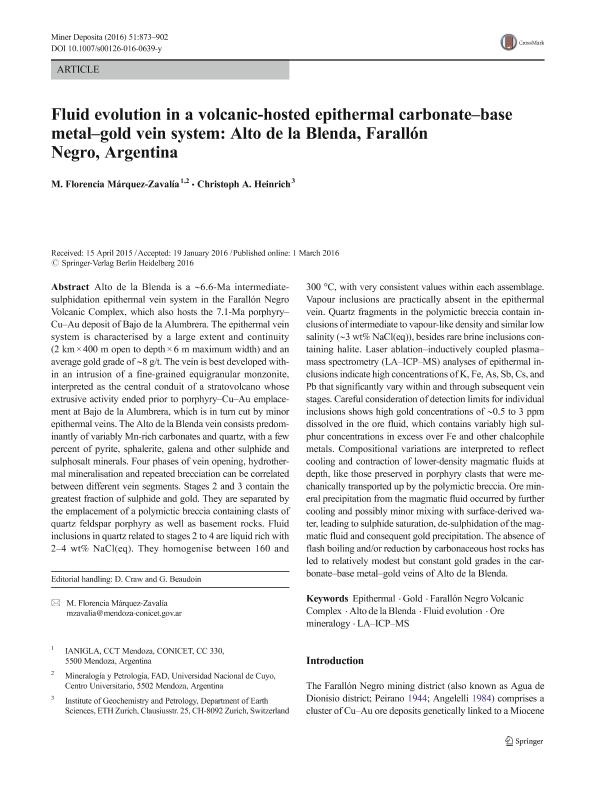Artículo
Fluid evolution in a volcanic-hosted epithermal carbonate–base metal–gold vein system: Alto de la Blenda, Farallón Negro, Argentina
Fecha de publicación:
10/2016
Editorial:
Springer
Revista:
Mineralium Deposita
ISSN:
0026-4598
Idioma:
Inglés
Tipo de recurso:
Artículo publicado
Clasificación temática:
Resumen
Alto de la Blenda is a ∼6.6-Ma intermediate-sulphidation epithermal vein system in the Farallón Negro Volcanic Complex, which also hosts the 7.1-Ma porphyry–Cu–Au deposit of Bajo de la Alumbrera. The epithermal vein system is characterised by a large extent and continuity (2 km × 400 m open to depth × 6 m maximum width) and an average gold grade of ∼8 g/t. The vein is best developed within an intrusion of a fine-grained equigranular monzonite, interpreted as the central conduit of a stratovolcano whose extrusive activity ended prior to porphyry–Cu–Au emplacement at Bajo de la Alumbrera, which is in turn cut by minor epithermal veins. The Alto de la Blenda vein consists predominantly of variably Mn-rich carbonates and quartz, with a few percent of pyrite, sphalerite, galena and other sulphide and sulphosalt minerals. Four phases of vein opening, hydrothermal mineralisation and repeated brecciation can be correlated between different vein segments. Stages 2 and 3 contain the greatest fraction of sulphide and gold. They are separated by the emplacement of a polymictic breccia containing clasts of quartz feldspar porphyry as well as basement rocks. Fluid inclusions in quartz related to stages 2 to 4 are liquid rich with 2–4 wt% NaCl(eq). They homogenise between 160 and 300 °C, with very consistent values within each assemblage. Vapour inclusions are practically absent in the epithermal vein. Quartz fragments in the polymictic breccia contain inclusions of intermediate to vapour-like density and similar low salinity (∼3 wt% NaCl(eq)), besides rare brine inclusions containing halite. Laser ablation–inductively coupled plasma–mass spectrometry (LA–ICP–MS) analyses of epithermal inclusions indicate high concentrations of K, Fe, As, Sb, Cs, and Pb that significantly vary within and through subsequent vein stages. Careful consideration of detection limits for individual inclusions shows high gold concentrations of ∼0.5 to 3 ppm dissolved in the ore fluid, which contains variably high sulphur concentrations in excess over Fe and other chalcophile metals. Compositional variations are interpreted to reflect cooling and contraction of lower-density magmatic fluids at depth, like those preserved in porphyry clasts that were mechanically transported up by the polymictic breccia. Ore mineral precipitation from the magmatic fluid occurred by further cooling and possibly minor mixing with surface-derived water, leading to sulphide saturation, de-sulphidation of the magmatic fluid and consequent gold precipitation. The absence of flash boiling and/or reduction by carbonaceous host rocks has led to relatively modest but constant gold grades in the carbonate–base metal–gold veins of Alto de la Blenda.
Archivos asociados
Licencia
Identificadores
Colecciones
Articulos(IANIGLA)
Articulos de INST. ARG. DE NIVOLOGIA, GLACIOLOGIA Y CS. AMBIENT
Articulos de INST. ARG. DE NIVOLOGIA, GLACIOLOGIA Y CS. AMBIENT
Citación
Marquez Zavalia, Maria Florencia; Heinrich, Christoph A.; Fluid evolution in a volcanic-hosted epithermal carbonate–base metal–gold vein system: Alto de la Blenda, Farallón Negro, Argentina; Springer; Mineralium Deposita; 51; 7; 10-2016; 873-902
Compartir
Altmétricas




